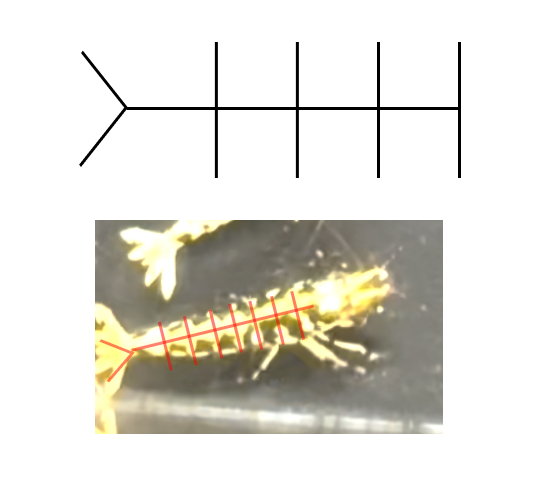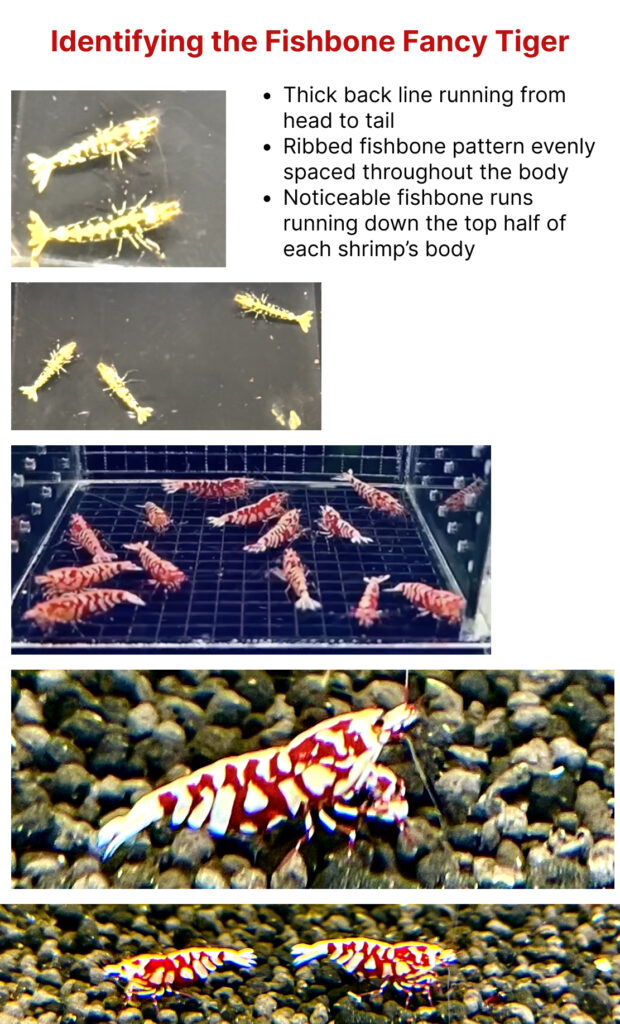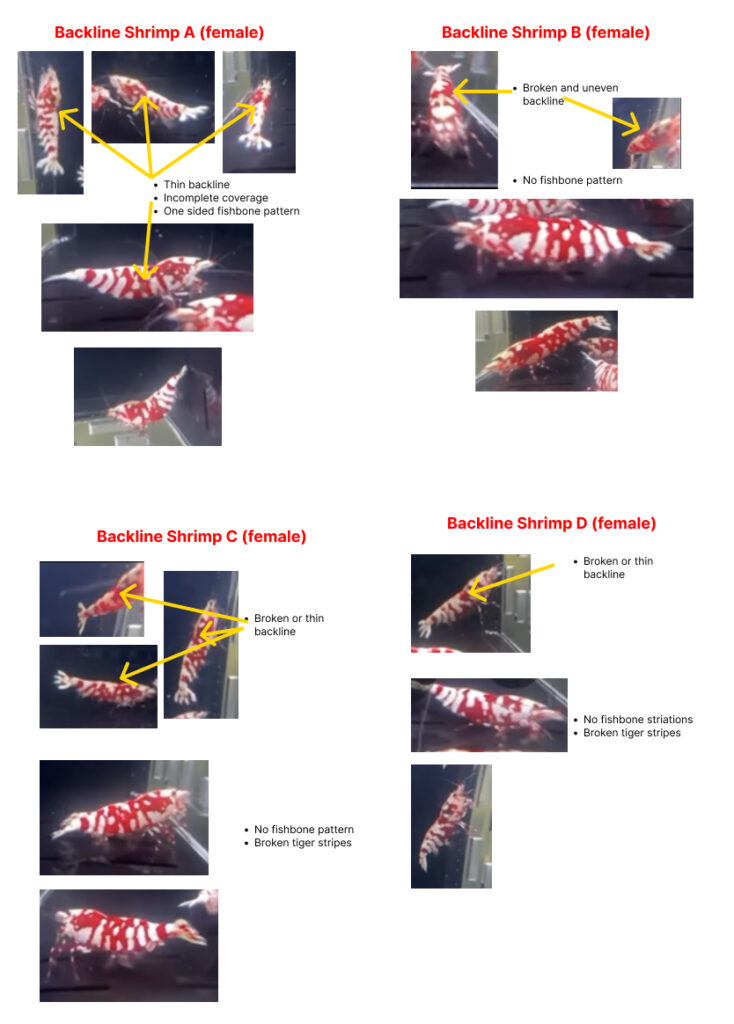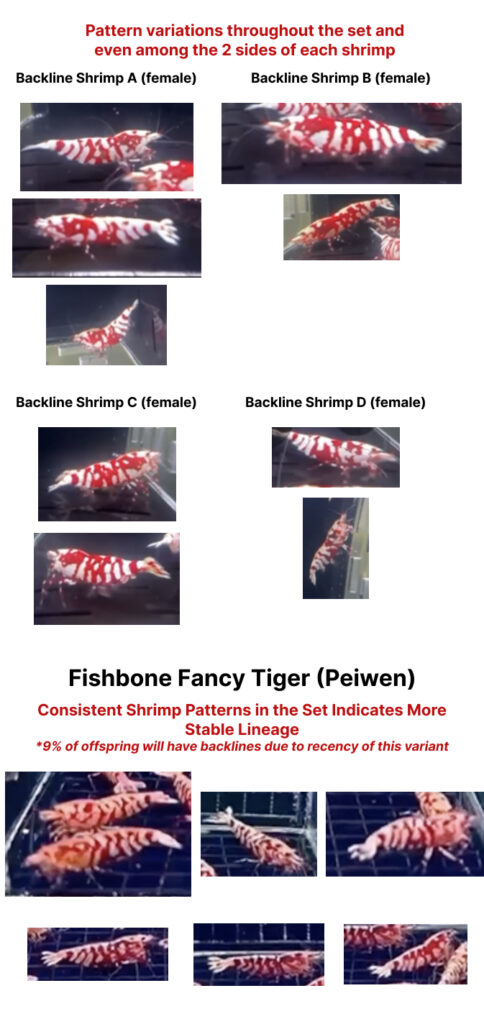Recently, I was asked an important question about Fishbone Fancy Tiger. While I don’t like direct comparisons with other breeders’ stock, this topic deserves attention.
Since the fishbone fancy tiger is a new and rare variant, I figured it’d be good to do a full write up on how to identify a true fishbone fancy tiger.
Some Context:
There was discussion around 2 similar sets of shrimp: the Fishbone Red Fancy Tiger and the Backline Red Fancy Tiger. There was a massive price difference. A lot of people wondered why.

Let’s start from the basics…
What is the fishbone pattern?
A fishbone pattern is the line that runs along the back of the shrimp. This pattern is a solid white line that runs along the shrimp’s back, with smaller, symmetrical lines branching out from it at regular intervals, looking like the fish’s ribs.

How to identify a high grade fishbone fancy tiger?
• Look for a clear, continuous line along the back
• Check for regular, symmetrical branching lines with even spacing
• The pattern should be distinct and well-defined
• It should be present in a significant portion of the population
Be cautious of:
• Irregular or broken back lines
• Inconsistent or asymmetrical branching
• Patterns that appear in very few shrimp in a colony These might be interesting variations, but they’re not true fishbones

What’s the difference between a fishbone fancy tiger and a backline fancy tiger?
• Similarity: Both fishbone and backline fancy tigers have a distinctive line running from head to tail. This “backline” is a shared characteristic that gives these shrimp their eye-catching appearance
•The difference is the ribs of the fishbone. The ribs should be evenly spaced, of even length and symmetrical in a fishbone fancy tiger.
•The backline should not be thin or broken. Sorry sometimes I couldn’t tell from the video quality if the backlines were broken or thin, but I took my best guess.

Why is there such a big price difference between a fishbone fancy tiger and backline?
• The quality between these two sets differs substantially. Sorry about the poor image quality but you can still see there is a noticeable difference in shell thickness and color opacity between the two sets.
• Backline fancy tigers: exhibit back lines, but some are broken or thin.
• Fishbone fancy tigers: mostly feature a thick, unbroken line running the entire length of the shrimp, though some individuals may display thinner fishbones.
• Fishbone fancy tiger: more consistent and symmetrical tiger striping.
• Backline set: some stripes are broken, and others form more of a panther-like pattern.
International contests typically feature sets of shrimp rather than individuals because a set better represents the stability of the lineage. Uniformity within a set indicates stable genetics and a higher likelihood of offspring inheriting the parent’s traits.
• Backline set: Significant variation among individual shrimp. This could potentially indicate that they were selectively chosen from a larger pool of Red Fancy Tigers (RFTs) in order to make a set, instead of a variant lineage. This is just my guess, for confirmation and information about breeding outcomes you should talk to the breeder directly. This is not an issue if you don’t plan on breeding your own lines and just want pretty shrimp. They are definitely cool looking, I personally love fancy tigers.
• Fishbone fancy tigers: greater consistency among individuals. According to the breeder and inventor of this variant, Peiwen, this line is pretty new, with its first public appearance in the US at the 2024 NAISC. Approximately 9% of offspring retain the fishbone pattern, with an even smaller percentage achieving high grade status like the set in the images.
• This rarity in breeding high-grade specimens contributes to the much higher price compared to standard backlines in the market.
• Backline set: The backline set appears to have four female shrimp, which limits breeding potential. Developing this trait would require selective breeding of offspring and efforts to stabilize it independently. Pattern inheritance percentages are unknown.
• Fishbone Fancy tigers: I am selling breeding sets with males and females from Peiwen’s own breeding stock. You’ll be months, if not years ahead of other breeders if this is the trait you want to develop and evolve. And we all know how important it is to be early in developing a new trait.

Fun Fact:
Breeders believe this is going to be the future standard RFT. Just like how PRLs were rare when I started over 15 years ago, but now they are the standard of crystal reds. They’re convinced that if someone continues to stabilize the gene and get the backline inheritance to above the current 9%, they could replace the current RFTs.
If you made it this far, thanks for reading! These are some tidbits that I’ve picked up from my visits to breeders in Taiwan. I hope this was useful.









